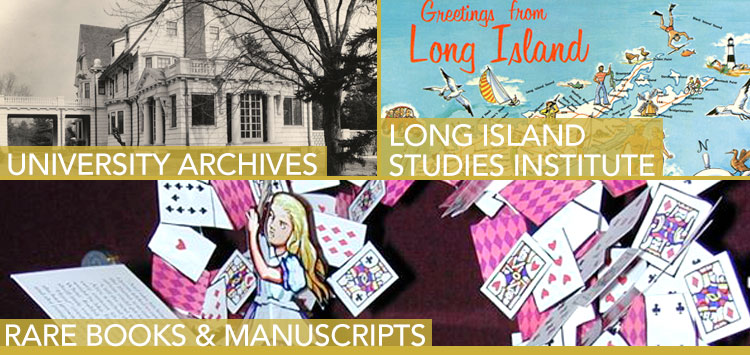Student Unrest: National Turmoil at Hofstra's Doorstep
by Steve Wagner
"What we are witnessing across the country, are Black and White students enraged against the mythological manifestations of White Anglo-Saxon Protestant Imperialistic views. This to me, is analogous to what may happen in the future to America. It will be the submission of demands by the leading thinkers and intellectuals, representing the attitudes of the mass- giving America a specified amount of time to either comply with our demands and change, or face the consequences of revolution."
-Frederick D. Nurse
The Hofstra Chronicle, March 13, 1969
| Origins of Student Unrest | Student Unrest :Reform & Revolution | Unrest & Protest at Hofstra University |
| Organization of Black Collegians: Protests of the Aftican American Community at Hofstra University |
| Anti-Radicalism: Satire & Ridicule |
| The Administration: Healing Divides & Accessing the Situation | The Alterative University | End Notes | Works Cited |
As the War in Vietnam continued to claim ever more lives, racial tensions flared across the country, and indignant youths rebelled against the monotony of their parents' generation, the Hofstra University community found itself deeply embroiled in the social unrest period of the late 1960s and early 1970s. Like other students at various American colleges and universities, many Hofstra students believed that their school was part of a wider system that stymied dissent and student participation while catering to select elites. The student population of Hofstra University was in no sense homogenous in respect to its political and social views. Conservatism was still visible, and politically-minded students often complained of rampant apathy on campus. Clearly, however, other students were adamant in their convictions and, in many cases, revolted by what they viewed as institutional injustice all around them.
The Origins of Student Unrest
The student protest movement in the United States aggregated from three already well-established social protest movements. According to Immanuel Wallerstein and Paul Starr in their book, Volume One: The University Crisis Reader, the student movement found its roots in the African American minority movement, the peace movement, and the cultural liberation movement. These enterprises would bring about greater awareness of social inequalities and create forums for the exchange of progressive concepts. "Radical" ideas challenging the authority of the Establishment were spread and discussed. Tactics, including civil disobedience and grassroots organizing, were brought into the main stream. By the end of the 1960s, some students on American campuses discussed their class schedules, while others spoke of revolution.1
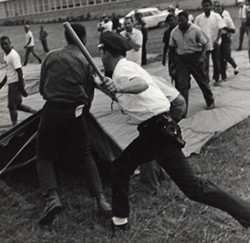
Police officer holding raised baton. Birmingham, AL. Harry Wachtel Collection
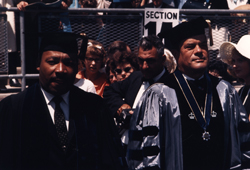
Dr. Martin Luther King, Jr. alongside Hofstra President Dr. Clifford Lord at Graduation Ceremony. Hofstra University, 1965
-
Listen to Malcolm X debate African American intellectual Louis Lomax at Madison Square Garden in 1964.
-
Listen to Dr. Martin Luther King Jr. speaking about racial injustice at Hofstra University in 1965.
The African American minority movement began as a struggle for civil rights and integration.2 Eventually, this front would transform into a campaign increasingly focused on "black power" and institutional liberation.3 The "Brown vs. The Board of Education" ruling in 1954, which lead to large-scale desegregation, was a pivotal turning point in regard to initiating the movement's full momentum.4 As the movement could not be considered completely unified, some black political leaders preached about the need for racial integration, while others taught that separatism was the only answer to the racial problem in America. As reform swept through America, nonviolent resistance, namely civil disobedience, became an acceptable means of protest. Students themselves became deeply involved with Freedom Rides and voter registration efforts.5 The Civil Rights Movement spanned a period of great progress, including achievements such as the passing of the Civil Rights Act of 1964 and the Voting Rights Act of 1965. However, this time also included devastating events such as the assassinations of Malcolm X in 1965 and Dr. King in 1968.
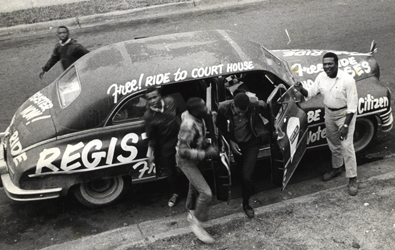
Ballot Bus' transporting new voters to register. Savannah, GA, 1964. Harry Wachtel Collection
-
Listen to various Hofstra University students react to King's assassination.
The peace movement began as a general protest against the creating and testing of nuclear weapons, and later became involved with strides to withdraw American troops from Vietnam. After the passing of the Nuclear Test Ban Treaty in 1963, the movement had become more widely accepted by mainstream America. After President Johnson announced the escalation of the war in Vietnam in 1965, the peace movement found renewed life and became increasingly integral to the student protest movement. Many student protesters used the war in Vietnam as a rallying cry against the Establishment, while they challenged the objectives of the conflict and the legitimacy of the draft.College students were particularly concerned with the war in Vietnam since most were of draft age. As stated in The University Crisis Reader, the movement began to question the very premise of American foreign policy as well as the wisdom of particular strategies.6 In total, over 58,000 American soldiers would die as a result of the conflict.7
-
Listen to clips from a symposium concerning nuclear weapons conducted by Hofstra University in 1961.
-
Listen to student leaders from Long Island universities and colleges discuss the Vietnam War and campus-related issues with Bill Moyers during a Newsday conference in 1968.
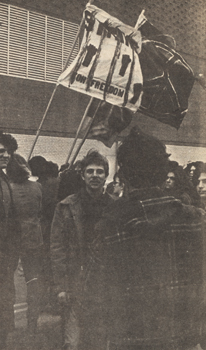
"Rallying ‘Round the Flags"… of peace, students from Long Island universities and colleges gathered in an A&S parking lot to protest the war." Hofstra University. The Hofstra Chronicle, 1970
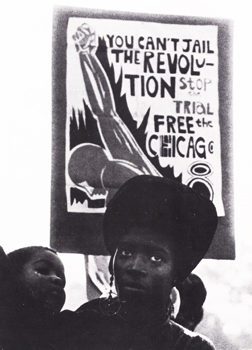
Woman and child in front of Chicago 8 protest poster. Used by permission of Alan Copeland
-
Listen to social activist and co-founder of the Yippies, Abbie Hoffman, talk about drug use, the New Revolution, and the benefits of a freer lifestyle at a Hofstra conference entitled "Drugs, Sex and Morality" in 1969.
The cultural liberation movement began shortly after World War I amongst a select group of intellectuals, poets, writers and the like, but later expanded rapidly during the 1950s with the so-called "Beat Generation." Members of the Beat Generation became revolted by the mundane life of American industrial bureaucracy. They were opposed to what they viewed as hypocrisy within the middle class. Many began smoking marijuana, listening to folk music, and even practicing Buddhism.8
During the 1960s, the word "hippie" began being used by the media to label the peace-loving, long-haired youths who often espoused the use of psychedelic drugs such as LSD (more colloquially known as acid), listened to rock and roll, and encouraged free love. The movement would become more political over time, as exemplified in the formation of the Youth International Party (Yippies). Members of this counter-culture helped legitimize nonconformity and dramatically altered the American social scene.9
Student Unrest: Reform and Revolution
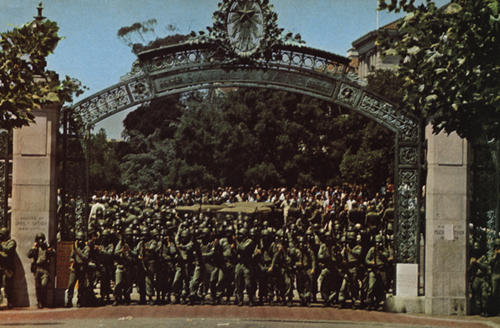
Between 2,700 and 3,000 National Guardsman occupied the city of Berkeley, CA during the take over of the People's Park in May of 1969.
Used by permission of Jeffery Blankfort
In 1964, the United States saw the first major incident of student unrest with the Berkley Free Speech Movement in California. After the start of the Vietnam War and Watts Riot in 1965, student protestors began to question traditional liberalism itself, including the allegedly liberal university. Many began to distrust their professors and administrators after they began to view the university as a vital organ in the corrupt corporate and military structure of modern American society. Education was seen as a mode of mass production. Patriotic Americans conditioned to be consumed by individualism and greed were its end products. Rather than a bastion of freethinking intellectualism, these students saw the university as a weapon being used by the architects of empire for war research, military recruitment, and the indoctrination of the next generation of capitalist minds. Breaking even further with the traditional Left, some were considered militant and often spoke freely about the need for revolution and the overthrow of the "Establishment."10
George L. Brand, Director of the Office of Public Information at the U.S. Department of Health, Education and Welfare, who was certainly opposed to student militancy, addressed the causes of student unrest in the United States during his address at the 63rd annual Commencement ceremony at California State Polytechnic College on June 7, 1969.
Certainly, the militant rebels on the radical left have a lot to be militant about. They speak for a generation which has been asked to fight a war which was never explained to them properly, for which they think there's no rational explanation and in which they do not believe. They know that they will go to jail if they are found to possess marijuana, yet they have been told by some responsible sources it is not addictive and probably will not hurt them. They see billions of dollars being spent on television advertising designed to sell them cigarettes which they have been assured might kill them. They hear of corruption in high office and the more informed know all about how millionaires can avoid paying taxes, and how oil companies get huge tax benefits from the government. There are non-geological faults in this land. They are cause for concern for any reflective person. There is the possibility of our sliding into a sea of decadence and corruption.
The truth is that the declining quality of intellectual and moral life everywhere has long been on a collision course with the education explosion. Every year more and more young men and women are going to college where they learn enough about the world to revolt against its hypocrisy.
Because of the size and the scope of this student population, the rebellion today has the appearance of a full-scale revolt. Student indignation and impatience have lead to violence. By the time most men reach middle age, they have lost the capacity for indignation. But youth has an unlimited capacity for indignation. Today it is being expressed. We cannot endorse some of the extremes to which this indignation has led, but we must not ignore it.
Dissent and protest are guaranteed by the Constitution and they are essential to Democracy. And even if we do not always agree with the dissenters we should be prepared to fight to preserve their right to dissent so long as the dissenters do not violate the civil rights of others.11
Unrest and Protest at Hofstra University
Listen to student leaders from Long Island universities and colleges discuss the Vietnam War and campus-related issues with Bill Moyers during a Newsday conference in 1968.
Hofstra University was irrefutably affected and challenged by the events that were being played out on the local, national, and international stages during the 1960s and 1970s. Even the anatomy of university education itself was being examined and dissected. As one Hofstra student wrote in an anonymous letter dated February 19, 1969, "The school has failed to bring about any kind of creative thinking—either in its activities or in the life styles of individual students. Such ‘qualitative evolution' which should be the real goal of the university has been sacrificed for rapid expansion and status . . . It is a traditional notion that the running of the University should be solely the concern of a select few who are best qualified and ‘most experienced' in this area. This select group is of course the Administration."12 However, there were also students who were apathetic to the political and social issues gripping their nation and school. Still others were vehemently in opposition to the views of so-called "dissenters."
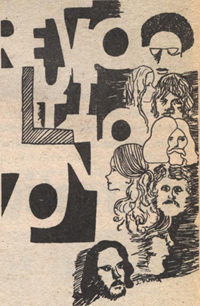 "Revolution." The Hofstra Chronicle, 1971
"Revolution." The Hofstra Chronicle, 1971
Activist students on Hofstra's campus wrote demands for the expansion of student rights, conducted meetings with faculty members and the Administration, held sit-ins, organized protests, coordinated boycotts, and even took over buildings on campus. As Paul Schirrman, a student, wrote in a letter dated May 2, 1969, "Most students, whether they realize it or not, feel oppressed by the system— they are looked down on by the faculty, financially exploited by the administration and forced to take meaningless requirements, as well as compete among themselves for grades." Schirrman continued by listing a set of demands including the abolishment of requirements outside of one's major (including compulsory physical education), a student-faculty senate to be comprised of 50 students and 50 faculty members, and the extension of the pass-fail system to any course outside of one's major. He concluded his letter by writing and underlining the following statement: "As for now, we must unite. All students share a mutual discontent. We must, together, express our desire for something better."13
Some faculty members truly empathized with student demands. Richard Sypher, an Instructor of English, wrote an open letter to the Hofstra Faculty dated February 21, 1969, compelling his fellow educators to engage in productive dialog with their students.
It seems to me that in the broadest sense the students have been telling us that our position of seniority and status gives us no monopoly on intelligence, wisdom, reasonableness or rationality, and that we have severe moral deficiencies. They have [been] saying that by our silence we serve mainly to perpetuate an academic and societal system that is in many ways heinous and unjustifiable. They have accused us of making policy, curriculum and tenure decisions without seeking their attitudes and proposals for change. Their indictment of us has, in short, been thorough, accurate and devastating.
On the other hand, we, instead of responding open-mindedly and intelligently to their voices, have for the most part been defensive and thin-skinned, indeed either incapable of meeting the issues the students have raised, or unwilling to consider their ideas seriously. Student opinion must be heard, not to be reacted against but to help show us the way.14
Student demands varied with the passage of time as the character of the national and local scene was transformed. Additionally, demands varied among different groups of Hofstra students. The document entitled "Report of Subcommittee on Grievances of Student Affairs Committee," dated March 6, 1969, offers some explanations regarding the demands of the Coalition for Student Justice. Included in the list of twenty demands is the abolishment of mandatory physical education. According to the report, the Coalition for Student Justice believed, "it is an affront to an adult's intelligence to tell him that he must be physically fit."15 They also cited the fact that academic credit is not given for gym, but that it is given for the ROTC program, which is not an academic course. They believed that ROTC academic credit must be terminated considering it's a program where "people get credit for learning how to kill." The ROTC program had previously been mandatory, but was made voluntary in September of 1967 after significant student protest.16 Other demands included more student control over the formulation of their curriculum, the formation of four credit courses for independent study in all departments, and the end of cumulative finals.
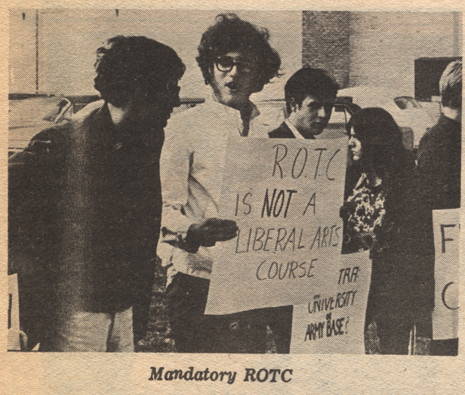
Hofstra students protest mandatory ROTC on campus. Hofstra University. The Hofstra Chronicle, 1967
After demands for the end of compulsory physical education and the abolition of academic credit for ROTC were not immediately met, a group of between one hundred and three hundred students staged a sit-in at the Administrative offices of Weller Hall on April 29, 1969. According to University President Clifford Lord in a letter to the members of the Board of Trustees, the students did not disrupt the activities of the office and actually cleaned the entire area with brooms and mops before departing.17
Lord sent another letter to the Trustees on May 10, after a committee met to discuss the physical education and ROTC issues but did not come to any conclusive votes. Lord discussed the general sense of outrage amongst the students. "Friday night the Student Senate office was the center of angry interchanges until after midnight, much of the talk frankly revolutionary, much of it threatening physical destruction, all of it remarkable because for the first time in history the Greeks, the moderates, and the usually constructive and conservative, were as angry as the radicals, and the polarization and unification of student sentiment we have so far avoided was a reality." At the end of his letter Lord wrote, "Anyone want a college presidency?"18
The Organization of Black Collegians: Protests of the African American Community at Hofstra
 "Black Power", The Hofstra Chronicle, 1971
"Black Power", The Hofstra Chronicle, 1971
Anti-Radicalism: Satire and Ridicule
A few students actively worked to thwart or at least mock the efforts of Hofstra students who ascribed to the viewpoints of the country's so-called "New Left." One group, the Political Affairs Club of Hofstra University, distributed flyers with a list of demands supposedly supported by the fictitious group S.U.D.S., or Students for an Ultimately Demanding Society. The purpose of the flyers was obviously to lampoon the demands of the student activist group S.D.S., or Students for a Democratic Society. These demands included the establishment of a "separate School of Demands to develop demands for those organizations that need some. . . . In league with demands of SDS to have the Administration announce the number of Feds, Narcos, and Fuzz on campus, we demand the number of all Heads, Draft-Dodgers, Professional Revolutionaries, and non ROTC students publicized; . . . denial of peace recruiters as well as war recruiters on campus;" the prohibition of silence and apathy; and "the right of every American citizen to protest regardless of whether he posses facts, issues, or logic. . . . If our demands are not met we will take over the nerve center of the campus, namely, the Rathskeller, the Gameroom, and the men's room in Hauser Hall."
IN ESSENCE, WE DEMAND THESE DEMANDS: THAT ALL DEMANDERS SHOULD BE ABLE TO DEMAND THAT WHICH THEY DEEM DEMANDABLE WITHOUT INTERFERENCE FROM THOSE DEMANDERS WHO DEMAND THAT THEIR DEMANDS BE DEMANDED BY ALL DEMANDERS. IN YOUR HEART YOU KNOW WE'RE RIGHT.22
The Administration: Healing Divides and Accessing the Situation
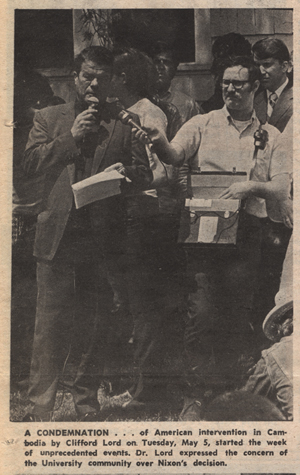 "A Condemnation"… of American intervention in Cambodia by Clifford Lord on Tuesday, May 5, stated the week of unprecedented events. Dr. Lord expressed the concern of the University community over Nixon's decision."
"A Condemnation"… of American intervention in Cambodia by Clifford Lord on Tuesday, May 5, stated the week of unprecedented events. Dr. Lord expressed the concern of the University community over Nixon's decision."
Hofstra University. The Hofstra Chronicle, 1970
According to University correspondence, the Administration did actively try to quell the student unrest. As required by New York State, the University submitted an official report to Albany outlining the procedures to be carried out in the case of student disruption on campus. While the outline clearly states that, "The university will do everything to protect student rights" and "Force of reason and persuasion will prevail;" the report also makes it clear that police would be called in if destruction of property occurred. Additionally, a delegation formed from the senate president or a delegate in his or her stead, a faculty member (the Chairman of Executive Committee), an administrator and one representative from Security would continue to urge the students to cease and desist.23
In 1970, some Administrators began organizing informal rap sessions with small groups of students, sometimes over coffee, in order to better communicate and understand the student population. As University President Clifford Lord stated in a letter written on November 20, 1970, inviting a group of randomly selected students to a rap session, "The session will be completely unstructured. I will want to pick your brains on certain subjects, get the benefit of your thinking, and get some questions and suggestions."24 Administrator H.B. Miller wrote to student Todd Work that, "Several of us in [the] Administration feel that we may be too isolated from our student body even though we make a conscious effort to move about the campus and talk and listen."25 Topics included anything the students wished to address from the need for more parking to student radicalism.26
It is also evident that the rap sessions were used to some extent as a tool in order to ascertain the overall level of discontentment on campus. As reported by H.B. Miller in a letter to Dean Sal Luiso dated December 21, 1970, concerning a rap session he conducted, "The students made it clear that the group of so-called radicals were in the minority and were frowned upon by the majority. They also expressed the thought that the performance of the Student Senate was little less than a clown operation, which made practically no contributions to the University." After noting that only one of the five students present believed she could not really gain anything from her Hofstra experience, he wrote, "If this is 80% typical, Hofstra can be very happy. The group was unable to forecast any student unrest. However, they were not prepared to state that all is quiet on the Western Front."27
The Alternative University
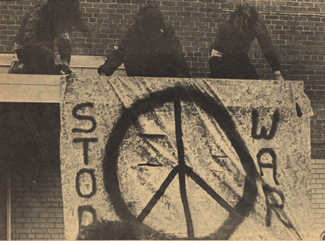
"Peace Now"… was the plea of over 2000 students who rallied in the A&S parking lot in Hempstead last week for an anti-war demonstration. Speakers from Hofstra, Adelphi, C.W. Post and Nassau Community College urged students to boycott classes and work for peace through community and campus workshops." Hofstra University. The Hofstra Chronicle, 1970
WE, THE STUDENT COMMUNITY OF HOFSTRA; ARE COMMITTED TO THE INDEFINITE SUSPENSION OF CLASSES.
THE SLAUGHTER OF OUR BROTHERS AND SISTERS IN INDOCHINA, IN OUR GHETTOS AND ON THE CAMPUS HAS AWAKENED US TO THE SICKNESS AND DEPREVITY WHICH IS PERVASIVE IN THIS SOCIETY. WE CANNOT, IN GOOD CONSIENCE, CONTINUE WITH BUSINESS AS USUAL.
FOR TOO LONG WE HAVE CONTINUED WITH BUSINESS AS USUAL WHILE OUR BROTHERS, BOTH AMERICAN AND VIETNAMESE, HAVE BEEN NEEDLESSLY SLAUGTERED IN VIETNAM. NOW THE SICKNESS OF WAR HAS SPREAD THROUGH INDOCHINA AND THE GENOCIDE WILL CONTINUE. FOR TOO LONG WE HAVE CONTINUED BUSINESS AS USUAL WHILE POLITICAL REPRESSION FLOURISHES IN THIS COUNTRY. FREE THE PANTHER 21, FREE BOBBY.
THE TIME HAS COME FOR ACTION. THE TIME HAS COME TO MOVE OUT OF THE CLASSROOM AND INTO THE COMMUNITY.
WE HAVE CLOSED THE UNIVERSITY SO AS TO ENABLE US TO BETTER MEET THE NEEDS OF CRISIS IN WHICH WE FIND OURSELVES. LET'S TAKE CARE OF BUSINESS.
POWER TO THE PEOPLE!!!
—The New Student Community: O.B.C.28
In the spring of 1970, a series of monumental events ripped through the collective consciousness of the American public. On April 30, 1970, President Richard Nixon announced the expansion of the war in Southeast Asia into Cambodia. Talks of a national strike on college campuses came to a head on May 4, 1970, when Ohio National Guardsmen opened fire on an unarmed crowd of Kent State student protestors and bystanders. The thirteen-second barrage of bullets left four dead and nine wounded. On May 15, 1970, police at Jackson State College in Mississippi fired into a crowd of student protestors, killing two and wounding twelve.29 All the while, Bobby Seale, cofounder of the Black Panther Party, and other members of his organization were still in jail.
Compounded by events on Hofstra's campus, including the suspension of fourteen students who sat-in on the exclusive University Club that was only open to the faculty and administration, Hofstra University allowed a drastic change in policy to take place in the wake of these national events. According to a document called "Statement of Policies and Procedures for Spring Semester 1970," any student could "substitute for the remainder of the semester alternative activities related to their concern over the present political and social travail. The University recognizes such activities as a valid part of the general educational process." 30 Students were allowed to receive a letter grade to be determined by their coursework prior to May 6, 1970, or select a pass-fail option for any class including those in their major. Hundreds of colleges and universities across the country took similar actions.
Groups of Hofstra students declared themselves "on strike," refusing to attend their normally scheduled classes. A "Strike Center" was established in the Student Center on campus in order to organize activities. Involved students started producing a "Strike Newsletter." The newsletter included news blurbs on political protest activities around Long Island and the nation. Students published lists of phone numbers in order to coordinate efforts with other universities and high schools. Interspersing these lists were various manifestos and editorial-styled letters expressing the concerns of individuals and entire student groups.31

Bobby Seale, co-founder of the Black Panther Party.
|
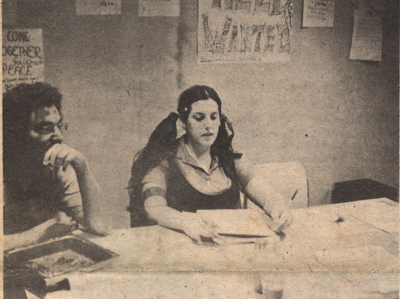
"Complaints Anyone?"… the Grievance Committee of the Strike Center will handle any complaints involving unfair grading by instructors under the format set by the recently issued policy statement." Hofstra University. The Hofstra Chronicle, 1970 |
The Strike Center was not the only new development to arise out of the turmoil of May of 1970. According to newsletters, during an emotionally-charged "large anti-war rally on the Main Quad, a call went out for faculty members and students who wished to establish a constructive channel for what was clearly a potentially very dangerous situation. That creative alternative was the Student-Faculty Ad Hoc Committee, an initial group of 500 teachers and students spontaneously organized on the department level." 32 The group alternatively called itself the "Student Faculty Ad Hoc Committee Against the War" and the "Student Faculty Ad Hoc Committee to End the War." The Committee claimed it represented over 2,500 students and faculty sympathetic to their position. The result of this radical student-faculty experiment was the "Alternative University" or A.U..
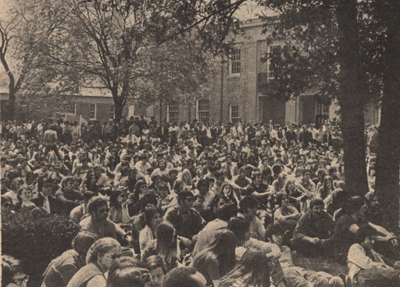
"No Longer Apathetic"… approximately 2000 Hofstra students turned out on May 6 to hear a variety of speakers discuss Cambodia and the tragedies at Kent State." Hofstra University. The Hofstra Chronicle, 1970
The Alternative University was accompanied by a daily "Ad-Hoc Bulletin" written and distributed by the Ad Hoc Committee with the purpose of keeping students and faculty aware of the developments within the transformed Hofstra campus. As the second issue of the newsletter dated May 12, 1970, states:
You have won the right to choose your course of study, please choose in such a way as to alter the personality of this University permanently. Please become involved in all our programs; which range from the presentation of alternate seminars to participation in Social and Political action committees. We sponsor a Boycott Campaign (Coke and Phillip Morris), local canvassing activities, provide a Speakers Bureau to the High Schools as to other organizations.33

Poster set up by the Strike Back Committee in opposition to striking students at Hofstra University in May of 1970
There were also anti-strikers on campus, including a group called the "Strike Back Committee." They opposed the suspension of their regularly held classes. As an editorial written in the Hofstra Chronicle on May 1, 1970, before the actual suspension of classes, asked:
How much longer will they believe that they can disrupt this school and expect amnesty?
How much longer will they cry about freedom and deny access to classes for students who choose to attend?
How much longer people? How much longer?34
Political and social unrest reached every strata of American society during the tempestuous 1960s and 1970s. The ambitions, ideals, and fears of American youth during this time altered the landscape of world politics and culture. This fact was made tangibly evident in everything from pop culture to drug use to the altered structure of the military. Hofstra University did not exist in isolation from the rest of the country. That same national turmoil enveloped Long Island as well, and it was personal, dramatic, and very real.
End Notes
- Wallerstein, Immanuel, and Paul Starr, eds. Volume One: The University Crisis Reader. New York: Random House, 1971. Xxi.
- Wallerstein, Immanuel, and Paul Starr, eds. Volume One: The University Crisis Reader. New York: Random House, 1971. Xxi.
- Wallerstein, Immanuel, and Paul Starr, eds. Volume One: The University Crisis Reader. New York: Random House, 1971. Xxii.
- Brunner, Borgna and Elissa Haney. "Civil Rights Timeline." Information Please. 2007. Pearson Education, Inc. 1 August 2007. <http://www.infoplease.com/ spot/civilrightstimeline1.html>.
- Wallerstein, Immanuel, and Paul Starr, eds. Volume One: The University Crisis Reader. New York: Random House, 1971. Xxi.
- Wallerstein, Immanuel, and Paul Starr, eds. Volume One: The University Crisis Reader. New York: Random House, 1971. Xxii.
- Nofi, Al. "Statistical Summary: America's Major Wars." The United States Civil War Center. 13 June 2001. 1 August 2007.
< http://www.cwc.lsu.edu/other/stats/warcost.html>. - Wallerstein, Immanuel, and Paul Starr, eds. Volume One: The University Crisis Reader. New York: Random House, 1971. Xxii.
- Wallerstein, Immanuel, and Paul Starr, eds. Volume One: The University Crisis Reader. New York: Random House, 1971. Xxii.
- Wallerstein, Immanuel, and Paul Starr, eds. Volume One: The University Crisis Reader. New York: Random House, 1971. Xxiii.
- Speech by George L. Brand. "Student Unrest Collection, 1964-1978." Hofstra University Archives. Hofstra University. 7 June 1969. Box 1, Folder 6.
- "One Dimensional Hofstra" from a Student Dissident to University. "Student Unrest Collection, 1964-1978." Hofstra University Archives. Hofstra University. 19 January 1969. Box 1, Folder 3.
- Correspondence from Paul Schirrman to University. "Student Unrest Collection, 1964-1978." Hofstra University Archives. Hofstra University. 2 May 1969. Box 1, Folder 4.
- Correspondence from Richard Sypher to Faculty. "Student Unrest Collection, 1964-1978." Hofstra University Archives. Hofstra University. 21 February 1969. Box 1, Folder 3.
- "Report of Subcommittee on Grievances of Student Affairs Committee." "Student Unrest Collection, 1964-1978." Hofstra University Archives. Hofstra University. 6 March 1969. Box 1, Folder 3
- Rosenberg, Ronald. "Finally, ROTC To Be Voluntary." The Hofstra Chronicle. 13 April 1967.
- Correspondence from President Clifford Lord to Board of Trustees. "Student Unrest Collection, 1964-1978." Hofstra University Archives. Hofstra University. 29 April 1969. Box 1, Folder 4.
- Correspondence from President Clifford Lord to Board of Trustees. "Student Unrest Collection, 1964-1978." Hofstra University Archives. Hofstra University. 10 May 1969. Box 1, Folder 4.
- Correspondence from Organization of Black Collegians to President Clifford Lord. "Student Unrest Collection, 1964-1978." Hofstra University Archives. Hofstra University. 21 February 1969. Box 1, Folder 3.
- Student University Senate Meeting. "Student Unrest Collection, 1964-1978." Hofstra University Archives. Hofstra University. Box 1, Folder 4.
- Correspondence from President Clifford Lord to Board of Trustees. "Student Unrest Collection, 1964-1978." Hofstra University Archives. Hofstra University. 6 May 1969. Box 1, Folder 4.
- S.U.D.S flyer by the Political Affairs Club of Hofstra University. "Student Unrest Collection, 1964-1978." Hofstra University Archives. Hofstra University. Box 1, Folder 3.
- Correspondence from Hofstra University to Dr. Frederick M. Binder, Associate Commissioner for Higher Education. "Student Unrest Collection, 1964-1978." Hofstra University Archives. Hofstra University. Box 1, Folder 6. 17 June 1969.
- Correspondence from Shel Shulman. "Student Unrest Collection, 1964-1978." Hofstra University Archives. Hofstra University. Box 2, Folder 1. 14 April 1970.
- Correspondence from H.B. Miller to Todd Work. "Student Unrest Collection, 1964-1978." Hofstra University Archives. Hofstra University. Box 2, Folder 1. 4 December 1970.
- List of Rap Discussion Topics. "Student Unrest Collection, 1964-1978." Hofstra University Archives. Hofstra University. Box 2, Folder 1. 3 November 1970.
- Correspondence from H.B. Miller to Dean Sal Luiso. "Student Unrest Collection, 1964-1978." Hofstra University Archives. Hofstra University. 21 December 1970. Box 2, Folder 1.
- Organization of Black Colligates. "New Student Community." Strike Newsletter. Volume I, No. II. "Student Unrest Collection, 1964-1978." Hofstra University Archives. Hofstra University. Box 2, Folder 3. 8 May 1970.
- May 4 Task Force Students. "May 1-4 1970." Alan Canfora: May 4, 1970. 16 May 2006. 1 August 2007. < http://alancanfora.com/?q=node/5>.
- "Statement of Policies and Procedures for Spring Semester 1970." "Student Unrest Collection, 1964-1978." Hofstra University Archives. Hofstra University. Box 1, Folder 9. 8 May 1970.
- Strike Newsletter. Volume I, No. II. "Student Unrest Collection, 1964-1978." Hofstra University Archives. Hofstra University. Box 2, Folder 3. 8 May 1970.
- The Student-Faculty Ad Hoc Committee. Ad-Hoc Bulletin. Vol. I, No. VI. "Student Unrest Collection, 1964-1978." Hofstra University Archives. Hofstra University. Box 2, Folder 2. 18 May 1970.
- The Student-Faculty Ad Hoc Committee. Ad-Hoc Bulletin. Vol. I, No. II. "Student Unrest Collection, 1964-1978." Hofstra University Archives. Hofstra University. Box 2, Folder 2. 12 May 1970.
- The Hofstra Chronicle. Special Volume II, No. III. 1 May 1970.
Works Cited
- Brunner, Borgna and Elissa Haney. "Civil Rights Timeline." Information Please. 2007.
Pearson Education, Inc. 1 August 2007. <http://www.infoplease.com/spot/civilrightstimeline1.html>. - "Conference—‘Drugs on Campus'" CT 445. Hofstra University. Hofstra University Archives. 16 February 1968.
- Hoffman, Abbie. "Drugs, Sex and Morality." CT 462. Hofstra University. Hofstra University Archives. 1969.
- King, Dr. Martin Luther. "Dr. Martin Luther King Commencement Speech." CT 445. Hofstra University. Hofstra University Archives. 13 June 1965.
- Lomax, Louis and Malcolm X. "Debate between Louis Lomax and Malcolm X." CT 577. Hofstra University. Hofstra University Archives. 1964.
- May 4 Task Force Students. "May 1-4 1970." Alan Canfora: May 4, 1970. 16 May 2006. 1 August 2007. < http://alancanfora.com/?q=node/5>.
- Nofi, Al. "Statistical Summary: America's Major Wars." The United States Civil War Center. 13 June 2001. 1 August 2007.
<http://www.cwc.lsu.edu/other/stats/warcost.html>. - "Nuclear War Symposium." CT 402. Hofstra University. Hofstra University Archives. 9 November 1961.
- Schwartz, Marvin. "Dr. Martin Luther King Jr.—Assassination." CT 950. Hofstra University. Hofstra University Archives. 6 April 1968.
- "Student Unrest Collection, 1964-1978." Hofstra University Archives. Hofstra University.
- Wallerstein, Immanuel, and Paul Starr, eds. Volume One: The University Crisis Reader. New York: Random House, 1971.


